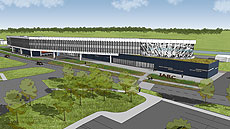IARC building aims for LEED certification
 |
| Fermilab is constructing the IARC Office, Technical and Education Building with a view to being green. The new building is on track to receive the U.S. Green Building Council's Leadership in Energy and Environmental Design certification. Rendering: Ross Barney Architects
|
If you travel Fermilab's streets, you've no doubt seen that work is proceeding quickly on the Illinois Accelerator Research Center. When it's finished, the project team hopes the new building will become the laboratory's first to achieve the U.S. Green Building Council's Leadership in Energy and Environmental Design (LEED) certification.
And because of changing Department of Energy regulations, it will also likely be the last.
When it's completed next year, IARC will cover about 83,000 square feet, and approximately 48,000 of that will be new construction. (The new building will join with the existing CDF assembly building, which will be refurbished after construction is completed.) The new center will house mostly offices and technical and educational facilities, and its purpose will be to bring private companies together with Fermilab scientists to find further practical uses for the lab's research.
It will also be remarkably energy-efficient, according to IARC building Project Manager Rhonda Merchut. The IARC team is aiming for a LEED gold certification for the new building, as required by the DOE at the time of the project's inception. That means that every element of the project, from design to purchasing materials to construction, has been carried out with the environment and energy conservation in mind.
For instance, the building has been designed with a geothermal HVAC system, consisting of 40 wells drilled 510 feet into the ground, allowing the earth to be used as a heat source in winter and a heat repository in summer. Seventy-six percent of the steel used in the building so far contains recycled content, Merchut said, and to date 91 percent of all waste generated by the construction has also been recycled. The goal is to maximize the amount of material that comes from local sources, she said.
The energy-efficient design of the new building is expected to save 30 percent over the baseline energy costs of a similar-sized building. In fact, that's a requirement to get the points needed for a LEED gold certification, Merchut said.
The new IARC building will include a pair of green roofs—essentially grass and vegetation planted on sections of the roof. The layer of soil and grass absorbs heat, Merchut said, and provides a nicer view for those in offices overlooking it.
With so many benefits, why is DOE turning away from LEED certification for its new buildings? Ironically, it's because they found a way to be more efficient.
DOE initially required LEED gold certification for any new buildings costing more than $5 million, starting in 2008. But according to Rod Walton, FESS environmental officer, a new DOE order issued in May 2011 signaled a different approach—federal guiding principles will now be the standard for environmentally friendly and energy-efficient projects.
These principles, Walton said, offer more freedom and better oversight and will take less staff time to comply with, since LEED demands extensive paperwork for approval. Additionally, Walton said, LEED is designed for office buildings, not the experimental halls Fermilab usually builds.
"It would drive us crazy trying to get LEED gold certification for Mu2e, for example," he said.
Whatever the method, the philosophy of sustainability and environmentalism remains the same, and it's one Fermilab is committed to. In fact, many of the principles already in place at the lab helped fulfill the LEED requirements for the IARC building.
"By and large, the lab does pretty well," Walton said. "We're conscientious."
—Andre Salles
|